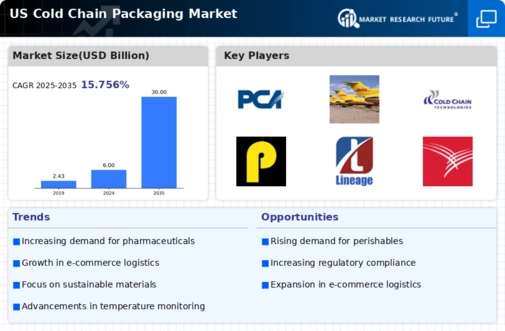E-commerce Growth in Food Delivery
The rapid expansion of e-commerce, particularly in the food delivery sector, significantly influences the cold chain-packaging market. With online grocery shopping becoming increasingly popular, the need for reliable cold chain solutions has intensified. Market analysis suggests that the online food delivery market is projected to reach $100 billion by 2026, necessitating robust cold chain-packaging systems to ensure safe transportation of temperature-sensitive items. This growth compels the cold chain-packaging market to develop packaging that can withstand various logistical challenges while maintaining optimal temperatures. As a result, companies are likely to invest in advanced materials and technologies to enhance the efficiency of their cold chain operations.
Rising Demand for Perishable Goods
The increasing consumption of perishable goods in the US is a primary driver for the cold chain-packaging market. As consumers become more health-conscious, the demand for fresh produce, dairy products, and meat has surged. This trend is reflected in market data, indicating that the perishable food segment is expected to grow at a CAGR of approximately 5.5% over the next five years. Consequently, the need for effective cold chain packaging solutions to maintain product integrity and extend shelf life is paramount. The cold chain-packaging market must adapt to this rising demand by innovating packaging solutions that ensure temperature control and minimize spoilage, thereby meeting consumer expectations for quality and freshness.
Consumer Preference for Convenience
The shift in consumer preferences towards convenience foods is a notable driver for the cold chain-packaging market. As busy lifestyles become the norm, there is a growing inclination for ready-to-eat meals and snacks that require minimal preparation. This trend is supported by data indicating that the convenience food market is expected to grow by 4% annually. The cold chain-packaging market must respond to this demand by providing packaging solutions that not only preserve the quality of these products but also offer ease of use. Innovations in packaging design, such as single-serve portions and resealable features, are likely to become more prevalent as manufacturers seek to cater to this evolving consumer behavior.
Regulatory Pressures for Food Safety
Regulatory pressures surrounding food safety are a critical driver for the cold chain-packaging market. The US government has implemented stringent regulations to ensure the safety and quality of food products, particularly those requiring temperature control. Compliance with these regulations is essential for manufacturers, as non-compliance can lead to significant financial penalties and reputational damage. The cold chain-packaging market must therefore invest in packaging solutions that meet these regulatory standards. This includes the use of materials that are not only effective in maintaining temperature but also compliant with safety regulations. As the regulatory landscape continues to evolve, companies will need to stay informed and adapt their packaging strategies accordingly.
Technological Integration in Supply Chains
The integration of advanced technologies within supply chains is transforming the cold chain-packaging market. Technologies such as IoT, blockchain, and AI are being increasingly adopted to enhance tracking, monitoring, and management of temperature-sensitive products. This technological shift is expected to improve operational efficiency and reduce waste, with estimates suggesting that companies could save up to 20% in logistics costs through better temperature management. The cold chain-packaging market is thus compelled to embrace these innovations to remain competitive. By leveraging technology, companies can ensure compliance with safety standards while providing transparency and traceability throughout the supply chain.



















Leave a Comment